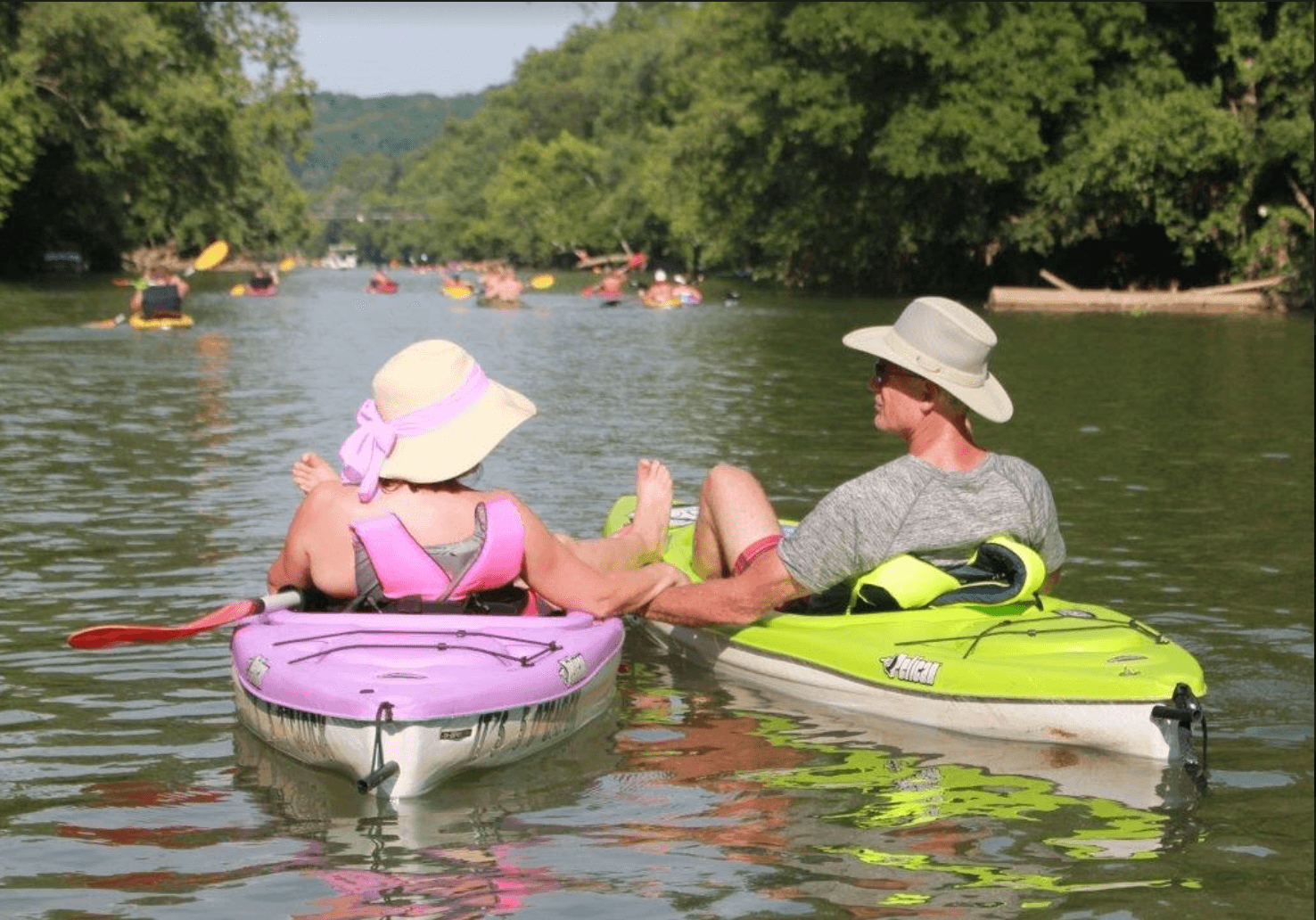
Opportunities aplenty for float trips in West Virginia this summer.
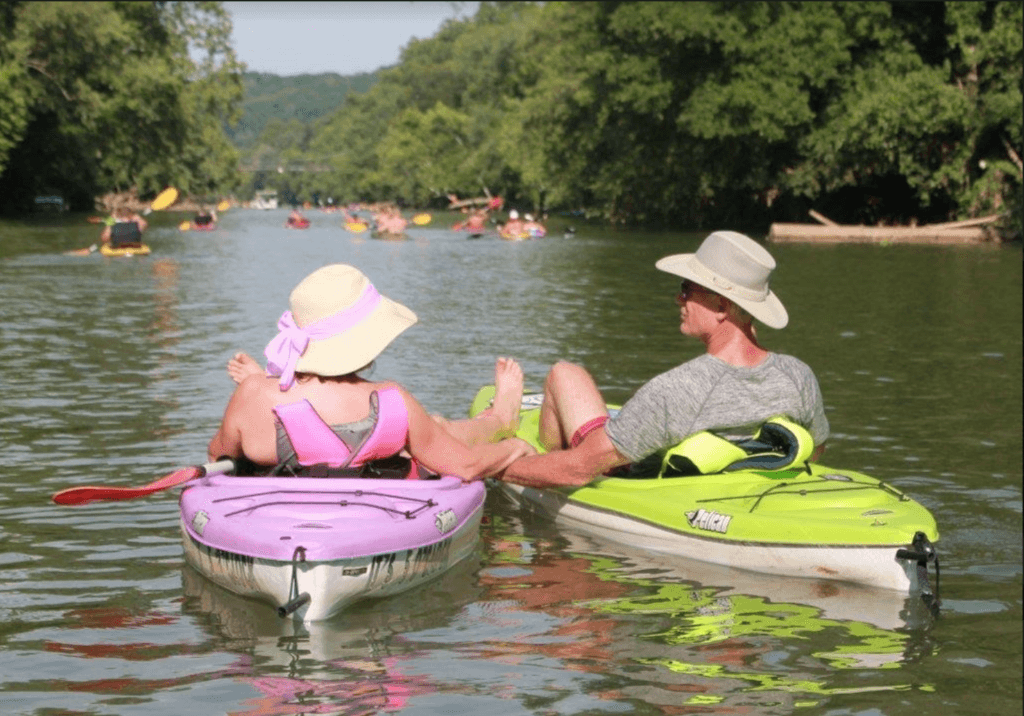
This story was originally published in the July 2021 issue of Wonderful West Virginia. To subscribe, visit wonderfulwv.com.
Written by Lori Kersey
From the Cheat River in the east to the Tug Fork along the Kentucky border and the Ohio River in the north, every region of West Virginia is a virtual water playground for paddlers of kayaks and canoes alike. No matter where you are in the Mountain State, there are float trip opportunities nearby. Here are six trips recommended by the paddlers who know them best.
Capon Bridge to Bloomery on the Cacapon River
For a little bit of excitement, paddle an 11-mile trip on the Cacapon River from Capon Bridge north to a Bloomery in Hampshire County, recommended by Tim Reese of Friends of the Cacapon. Reese describes the river as scenic and rustic, with few houses and lots of trees along the water.
Paddlers will pass Caudy’s Castle, a thousand-foot sandstone rock formation, and the trip includes two technical rapids for boaters to navigate. Reese says boaters should either take the trip with someone who’s been down it before or pull off to the side before the rapids and determine a plan.
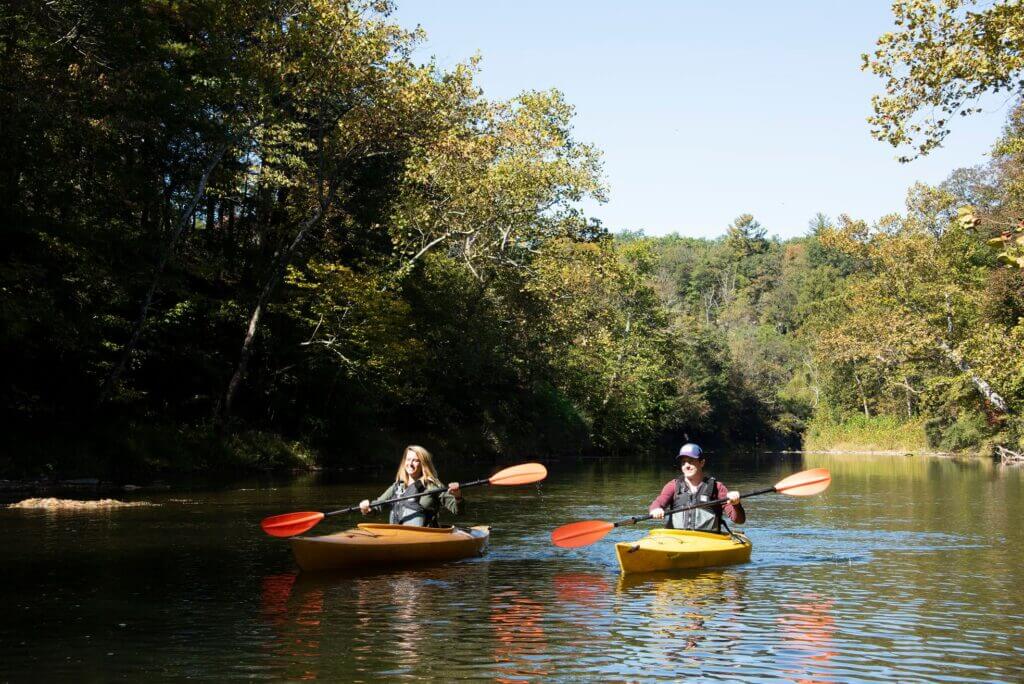
“What makes it such a popular piece of the river is that it has a little bit of excitement to it,” Reese says. “It’s nothing like the New River Gorge by any means, but sometimes when you’re taking a paddle it’s nice to look at the scenery and it’s nice to get some exercise. Every once in a while you like to have a little bit of splash and a little bit of excitement. That’s what this particular stretch offers.”
Holly Meadows to St. George on the Cheat River
For this adventure fit for paddlers of skill levels, Amanda Pitzer of Friends of the Cheat, recommends using local outfitters Blackwater Outdoor Adventures for an eight-mile trip from Holly Meadows to St. George in Tucker County. Owner and operator Patrick McCann suggests using a kayak or canoe for the distance.
“It’s a wonderful river that is easily accessible but still feels pretty wilderness-y,” McCann says. “You may see a handful of houses out there and some farmland, but you still feel pretty isolated.”
McCann says the river is wide and mostly flat. A few spots have currents stronger than a ripple, but not strong enough to be classified as rapids, he adds. “Swimming is excellent, particularly in mid-summer. It’s a relatively clean river—and in the height of summer, it’s really crystal clear.”
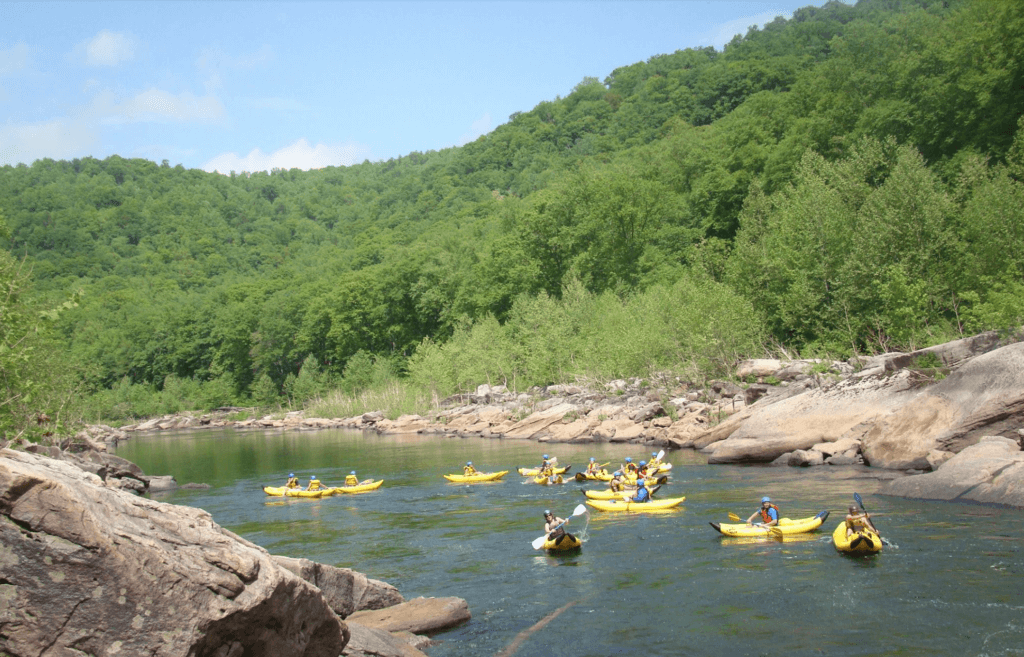
Julian to Boone County Water Park on the Coal River
Once heavily disturbed by the construction of Corridor G, the Coal River in recent years has been restored to its former glory. And for a quick-moving ride, Bill Currey, chair of Coal River Group, recommends a seven-mile paddle from the Donald Kuhn Juvenile Center in Julian to the Boone County Water Park. The trip has lots of curves and bends with white beaches beside them.
“If you go quickly, you can do it in maybe three hours,” Currey says. “If you lounge and swim and eat lunch along the way, you can spend four or five hours there on the thing. It’s just a beautiful, beautiful trip, surrounded by mountains and greenery and all that, as all the trips are.”
All the trips on the Coal River are rural with few houses and no access roads, Currey says.
“It’s definitely an adventure.”
Caldwell to Ronceverte on the Greenbrier River
If you’re looking for a calm ride with no rapids on the Greenbrier River, consider a six-mile stretch from Calwell to Ronceverte. Beverly Wolfe recommends the route and, as a co-owner of Greenbrier Campground, Cabins, and River Trips, she knows the river best.
“The Greenbrier is not the New River,” Wolfe says. “It’s nothing over a class II, and it’s something that I think is pretty accessible to pretty much anyone. There’s different stretches of it that are probably better for different people.”
Paddlers should watch the weather forecast and plan accordingly. The Greenbrier River is not dammed, which means the water levels depend on how much rain the watershed has recently had. “If we get a heavy rain, then the water is going to be up. And if we have a drought situation, the water is going to be down,” Wolfe says. More information on this and other float trips as well as a gauge for water levels can be found under “River trips” on the company’s website: greenbriverriver.com.
Around Buckley Island near Parkersburg on the Ohio River
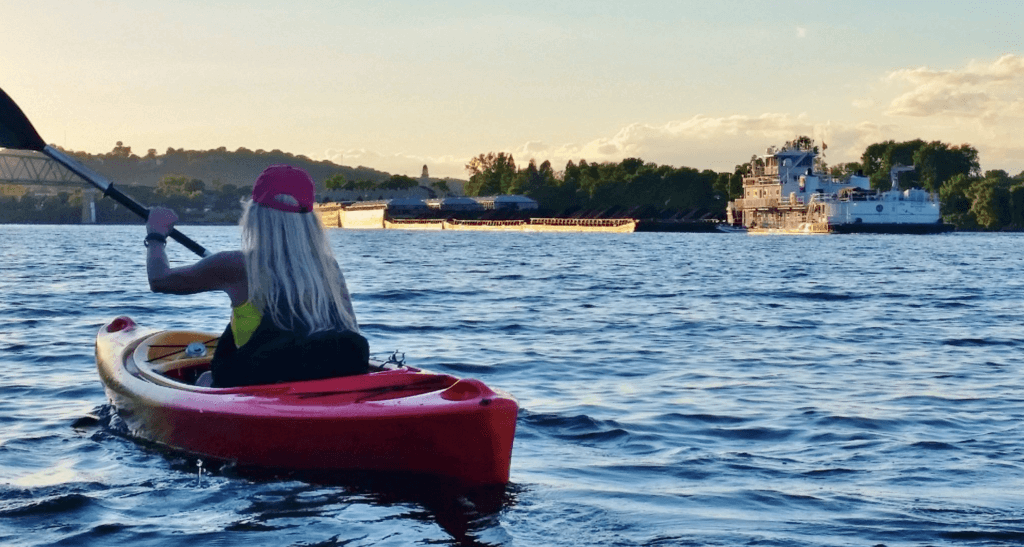
Take it easy on a six-mile, three-hour paddle on the Ohio River Water Trail around Buckley Island, located between Parkersburg and Marietta, Ohio.
“The Ohio River is relatively slow-moving, so most paddle trips are ‘out and back,'” says Lloyd Roberts, chair of the Wood County Alternative Transportation Council. “The river is more like a lake than a river.” No need to shuttle anywhere for this trip—the Williamstown Boat ramp is both the put-in and take-out point.
Through Williamson on the Tug Fork
For a view of West Virginia’s border with Kentucky, take the Tug Fork through Williamson. The focus of recent cleanup efforts, the river is known to locals for its fishing, too.
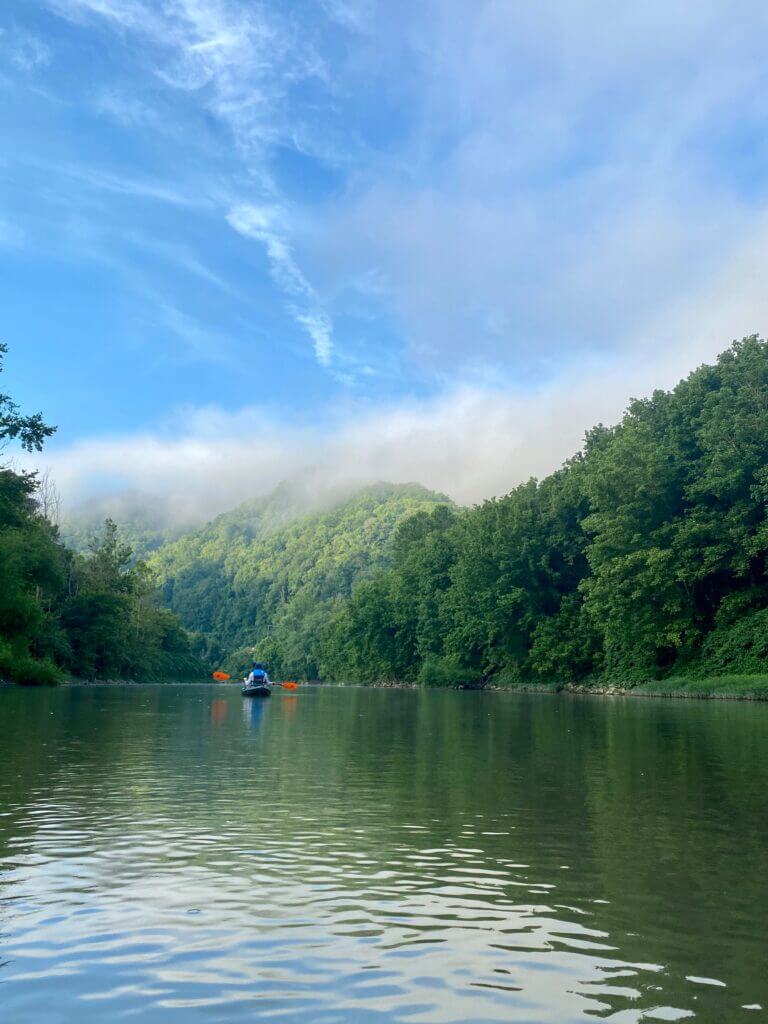
“The river is beautiful,” says John Burchett, a Williamson resident and member of the state’s new Flatwater Trail Commission. “It’s a draw to itself. And the smallmouth bass fishing that we have is absolutely amazing.”
A three-hour trip through Williamson starts at a put-in under the Second Avenue Bridge and ends at the mouth of Goodman Hollow. “You get a really nice mix of architecture of a green slope and a forested area,” Burchett says. “Then as you get further down, it’s forested on both sides. You have the railroad going through. You pass under U.S. 119 three times. It’s a nice mixture of scenery. It’s not one particular thing that you’re looking at the whole time.”
An important note for those enjoying water recreation on the Tug: there’s a low-water dam adjacent to the Williamson Water Plant that’s impossible to float over or pass by. Paddlers must exit the river and put in again past the dam.
Before You Go
Before you paddle, be sure to know state laws and regulations. Paddlers in West Virginia are required to have a personal flotation device in good condition for everyone on board at all times. Paddlers are also required to have on board an all-white light and a whistle, both of which can be useful in avoiding collisions.
“Share a paddling plan with a friend—where you plan to put in and take out and, of course, when you plan to return,” advises Lt. Warren Goodson of the state Division of Natural Resources Law Enforcement Division. “Know the rules of the road on congested waterways, but always assume that other boaters don’t see you. Dress for visibility in all weather conditions, wear a brightly colored PFD, and always have a light available.”
To learn more about water and paddling safety, Goodson recommends taking a free online safety course like the one at boaterexam.com.











